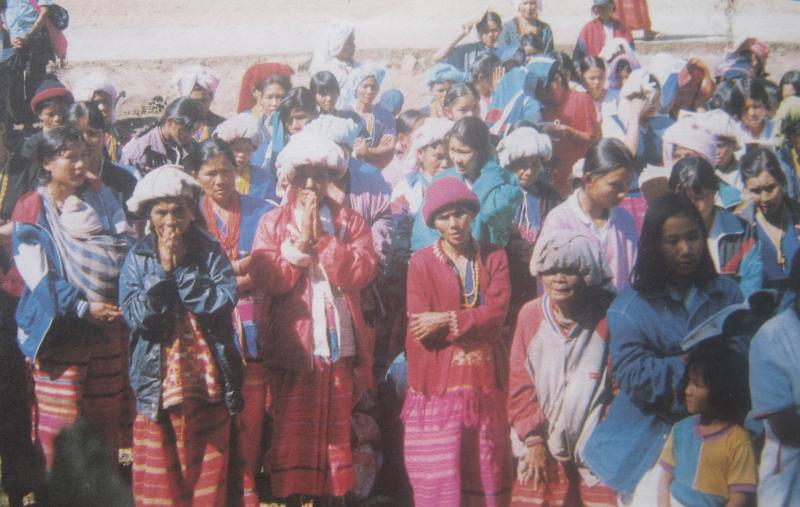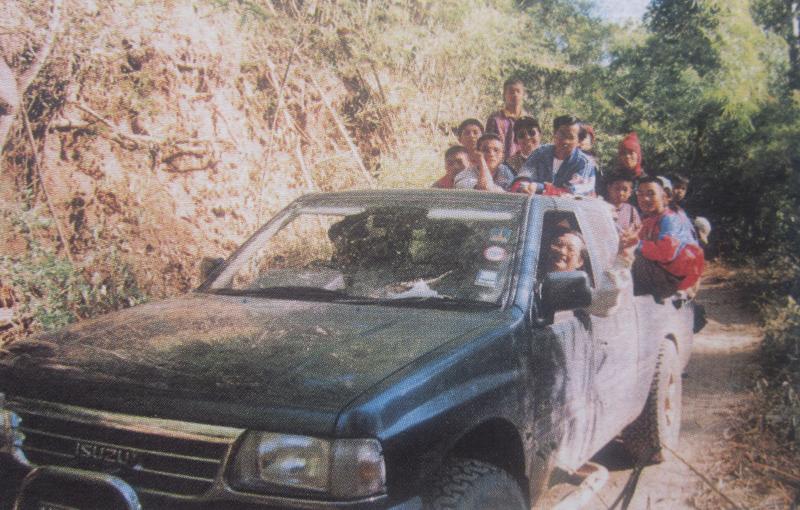I Hear The Karens Calling

By Gee-Gee O. Torres
Fr. Leo Ochoa, SDB is from Isabela, Negros Occidental. He was sent to Thailand while he was still a cleric and for the past 25 years he has been devoting himself to missionary work there. He kindly agreed to be Misyon’s guide in Thailand. He helped Editorial Assistant, Gee-Gee Torres, contact the different Filipino missionary groups. He drove her to almost all the places she went to. Here Gee-Gee tells her story about Fr. Leo.
Off to the South
We set of to the south of Thailand. We left Bangkok at four o’ clock in the morning to avoid the traffic. On our way down to the leprosarium in Ronphibun, Fr. Leo reminisced on his 18 years in the South. His story about the Karens caught my interest.
The Karens
The Karens are one of the seven hilltribes in Thailand. It is presumed that they originated from Tibet or Burma and have been living in Burma since 739 AD and are thought to have started moving into Thailand a couple of hundred years ago.
Karens build their villages at low altitudes. They are sophisticated farmers, and their villages are well laid out and permanent. They are unfortunately under much pressure as a result of land shortage and competition from Thais and much of their traditional style of life is being destroyed.
Fr. Doctor
Fr. Leo first met the Karens in 1985. The tribe leader went to the parish in Hua Hin. He was looking for a certain priest whom he called “Fr. Doctor”. Fr. Leo who was the parish priest then asked him, “Why are you looking for that priest?” “I’d like to ask for medicine against malaria,” answered the tribe leader. “Twenty years ago there were Salesian priests spending their vacation hunting at the border. They use to give us this medicine.”
Knowing that malaria was rampant in the Villages Fr. Leo packed some medicines for malaria and gave it to the tribe leader. He wanted to see their situation and so he went with the tribe leader to the village. The family of the tribe leader gladly welcomed him and called Fr. Leo ‘Fr.Doctor’.
Educational Program
Fr. Leo eventually gained their trust and was able to build good rapport with the villagers. The villagers told him about their wish of sending their children to school. He suggested that it would be best to send the children to the parochial school of the Diocese of Suratthani. The people agreed with Fr. Leo’s suggestion and so an educational program from kindergarten to elementary was initiated.
St. Thomas Chapel
St. Thomas was later on built in the village and it served as a “bridge Church” to get to know more Karens and introduce the Gospel to them. The chapel started with one family and as Catholic families started migrating to the village, the Catholic community gradually grew with Karen members.
Typhoon Gay
 After several years in Hua Hin, he was transferred to another parish in the South. When typhoon Gay hit in Thailand in 1989 his new parish was one of the places hardest hit. The typhoon left the place devastated. Many lives were lost; many houses and schools were destroyed; crops were damaged.
After several years in Hua Hin, he was transferred to another parish in the South. When typhoon Gay hit in Thailand in 1989 his new parish was one of the places hardest hit. The typhoon left the place devastated. Many lives were lost; many houses and schools were destroyed; crops were damaged.
Food Basket
He wanted immediately to help the victims of the typhoon but he could not. He was sick with gout and could hardly move. He stayed in his room at the second floor because the first floor of the convent was flooded. The local sisters living opposite the convent made an improvised pulley and attached one end to the window of Fr. Leo’s room and the other end to the window of he Sister’s house facing Fr. Leo’s room. They placed food in a basket, hung it on the pulley, then Fr. Leo would pull the rope at the other end to get his meal
Who are You?
During the typhoon calamity the Karen people saw how the Church helped them. At this point they began to wonder and ask, “Who are you? Why are you helping us?” "We are followers of Jesus and He tells us that we are all sisters and brothers. Thus, we are helping you,” said Fr. Leo. This was his last parish assignment. The following six years he was assigned in Bangkok and was involved in programs for the youth.
Visit to Chiang Mai
When Fr. Leo became the National Youth Director in 1995 he went to the North and visited youth groups in Chiang Mai, the second largest province in Thailand. Fr. Leo’s visit to the North reawakened his dream of working with the Karens...again. This year he is realizing this dream. He has been given a mission assignment to survey the situation of the Karens in the North.
The Karens are living along the border of Myanmar and Thailand from North to South. But majority of them can be found in 3 provinces: Mae Hongson, Chiang Mai and Tak. There are about 250, 000 Karens living in 15 provinces of Thailand.
Fr. Leo Writes to the Editor
Dear Fr. Niall,
Thank your very much for sending Gee-Gee to Thailand. I am sure that we have gained much from her visit. She must have really done a lot of good and encouragement to many of us, to me in a special way!
Her coming made me ‘homesick’ – homesick for my Columban family! I always wanted to show my gratefulness to the Columbans but had no opportunity until Gee-Gee visit to Thailand.
I was a knight of the altar of Fr. Robert Burke and Legion of Mary members of Fr. John Holloway during my elementary years. It was from them that the seed of my vocation developed I wanted to join the Columbans but no local vocations were accepted yet during those days. Fathers Bob and John gave me some options and I chose to join the Salesian at the DBTC-Victorias. I was sent by the Salesian Fathers to Pampanga for aspirantate.
I won’t be a Salesian, a priest, a missionary now, if it were not from the examples and support of those two beloved Columbans. Of course, I couldn’t also forget the continued support of Fr. Bernard Cleary and the others. Yes, they were all good Columban missionaries in Isabela, Negros Occidental.
My becoming a missionary priest is still a mystery to me. My family was then very poor. How did Fr. Holloway arrange my stay at the seminary without me paying is still a mystery to me. the more grateful I feel to the Columbans – their ways of making things possible, ways of offering possibilities to those who have less in life.
To make this spirit of gratitude more tangible was my determination to remain a missionary to proclaim God’s love to all. My simple task of driving Gee-Gee around to visit the Filipino missionaries as much as her (and may) schedule allowed was very encouraging to me. I found out that the Filipino Missionaries were really loved by the Thai people. The main reason was that they dialogue with them, they are one of them!
Father Leo
